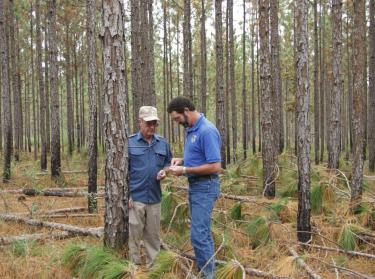Protecting Longleaf Pines
As a woodland owner, you can help keep remaining longleaf pine forests healthy. The key is to maintain the conditions in which longleaf pines thrive—plentiful sun by letting more sunlight get to the forest floor, limited competition, and fire that’s frequent but not destructive. With these forest management activities, you can create just the right mix:
Prescribed burns. Longleaf pines need fire, both to take root and establish themselves at the seed stage, and to prune lower limbs and limit competition from hardwoods and other trees when they mature. So controlled fires are absolutely necessary to keep a longleaf pine forest healthy. These fires must be timed and managed correctly, however, because the trees are vulnerable to fire during specific stages of their growth. Seedlings less than a year old and seedlings just out of the grass stage can be damaged or destroyed by fire. That means you must make sure to consult a professional for guidance and assistance (and any necessary permits) before trying a burn on your own.
Thinning. Longleaf pines are among the most shade-intolerant pines. They thrive in woods that are open, where lots of sunshine can reach the trees and the forest floor. If you are interested in creating wildlife habitat for species like Quail, that means reducing tree density in your woods to as little as 250 trees per acre. If you are interested in growing longleaf for income, then you would want a higher density, 500-900 trees per acre. These density ranges can protect your longleaf pines and encourage new ones to grow. One way to keep the density in check is to thin less desirable trees, either by mechanical means or with herbicides.
Harvesting. If you have an uneven-aged stand of longleaf pines, where older, larger trees grow alongside younger ones, you may wish to cull some of the bigger trees to allow smaller trees the sunlight they need to flourish. In this case, a well-managed timber harvest can provide considerable economic benefit and improve the overall health of your woods. Because most viable longleaf seeds fall within 65 feet of their parent, shelterwood harvesting typically works best for longleaf pine. Shelterwood harvesting selectively removes some mature trees while leaving others to “shelter” seedlings or produce seeds. Once seedlings are established and at least one year old—it’s best if they’re in the grass stage—the parent trees can also be harvested. Consult your forester to discuss whether shelterwood harvesting or other harvesting techinques like group selection might be appropriate for your forest and the objectives that you have for your land.
Controlling invasives and pests. Longleaf pines are highly resistant to pests, but you may want to watch for and control bermudagrass, hardwoods, and other growth that can compete with the pines.
These management activities can also help you cultivate new longleaf pine stands, or restore them in sites where they once grew.
How can I get more tips?
It’s simple! Enter your email below.

